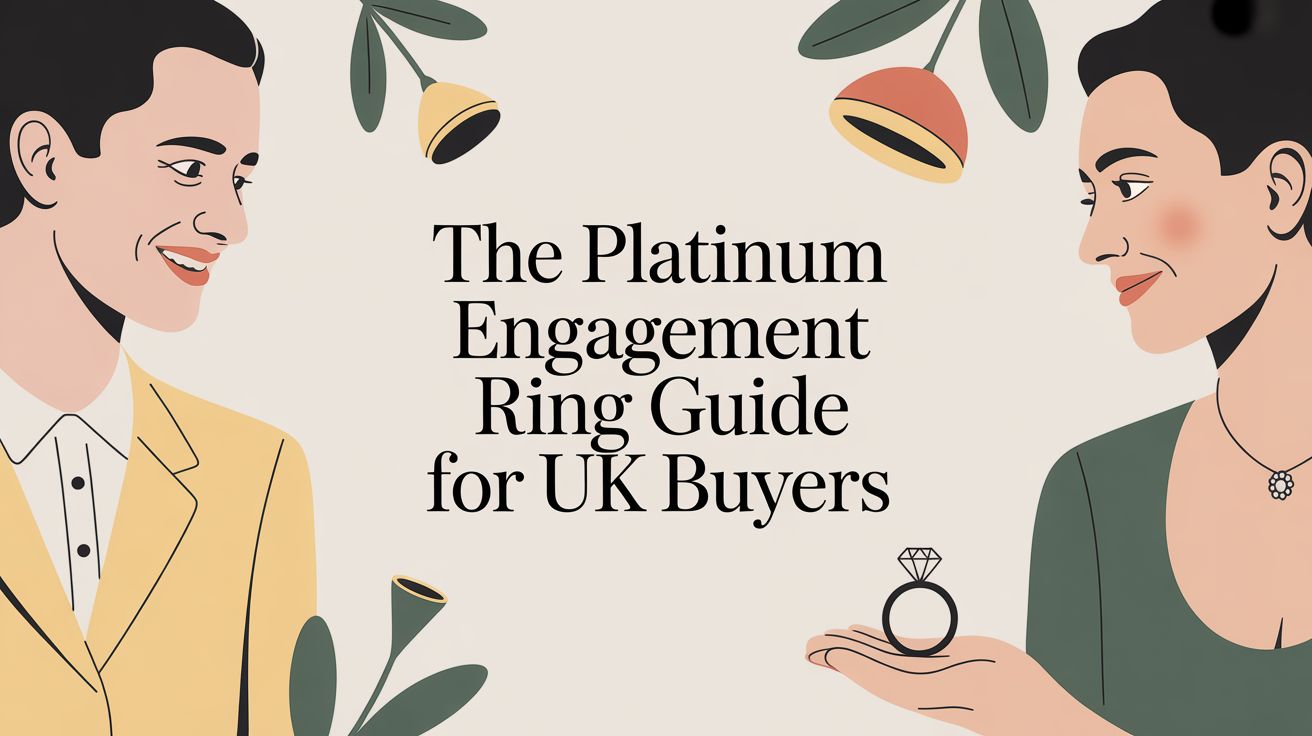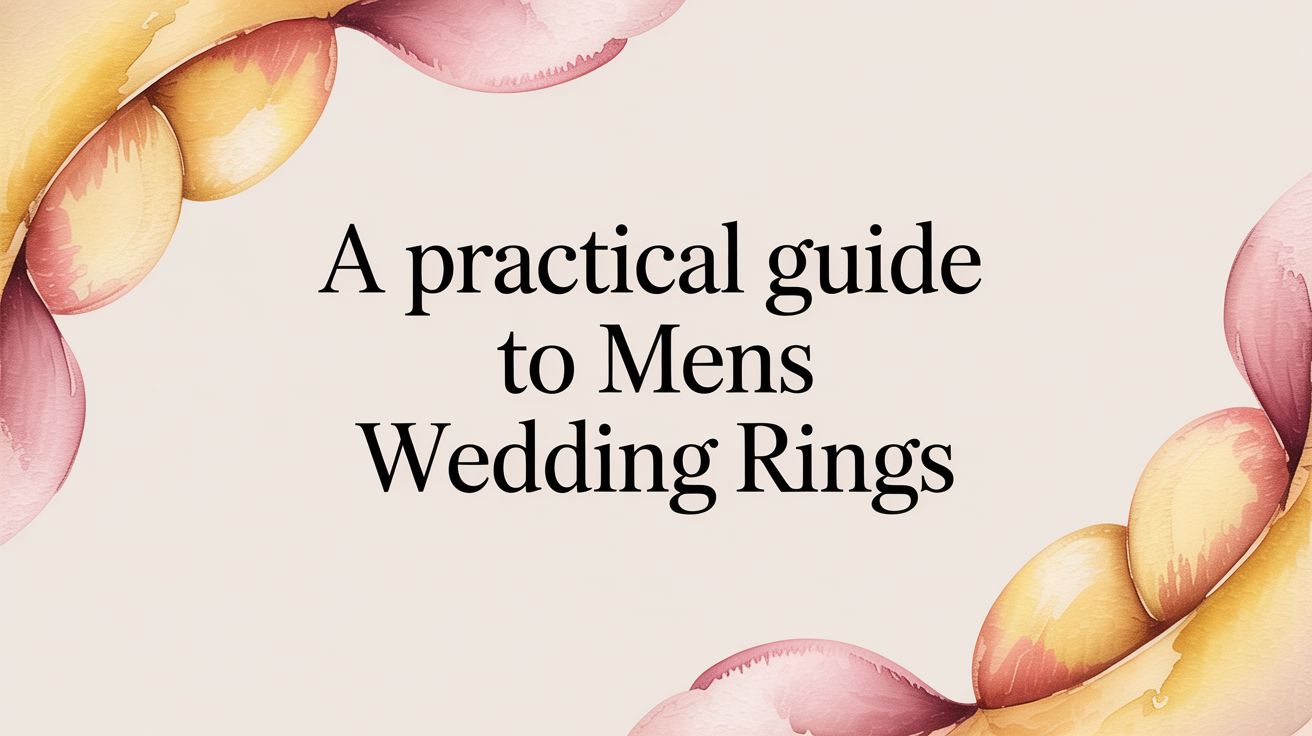A platinum engagement ring is the ultimate mark of enduring love, chosen for its natural white brilliance, incredible durability, and prestigious rarity. It offers a secure and beautiful setting that makes a diamond pop, promising a lifetime of wear with very little fuss.
Why Choose a Platinum Engagement Ring?
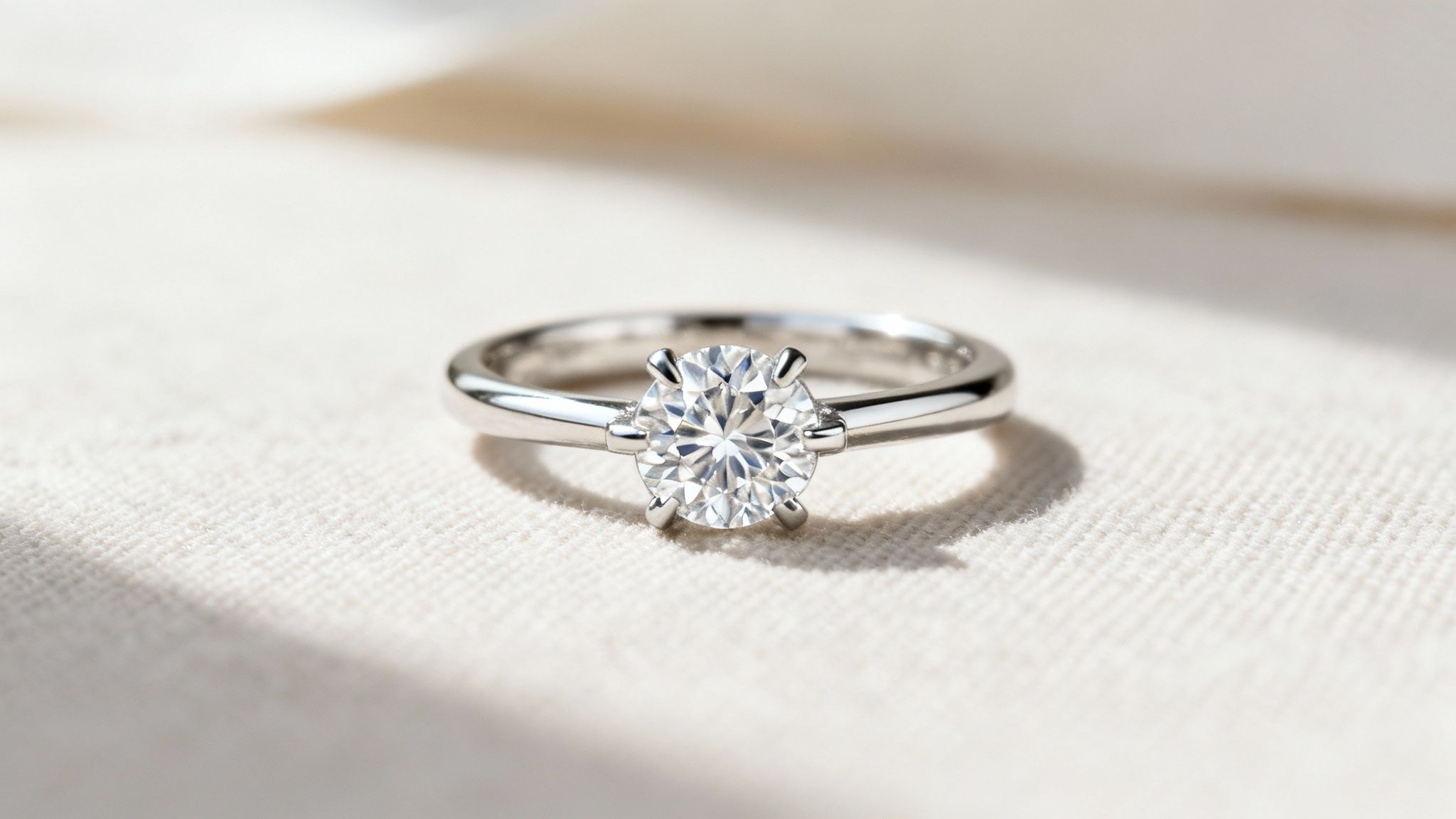
Choosing the metal for an engagement ring is one of the biggest decisions you'll make, as it sets the tone for the entire piece. A platinum engagement ring isn't just a choice; it's a statement about permanence and purity.
Unlike other metals that need plating to get that white sheen, platinum is naturally and eternally white. This means its cool, bright lustre will never fade, yellow, or tarnish over time.
This quality makes it the perfect backdrop for a diamond. Think of it as the ultimate canvas for your gemstone—its neutral tone amplifies a diamond's fire and brilliance, making it appear even more dazzling. The metal doesn't fight for attention; it elevates the stone it holds.
A Symbol of Strength and Purity
Beyond its colour, platinum has a unique blend of strength and purity that really connects with the symbolism of marriage. It's one of the densest precious metals, giving it a substantial, reassuring weight on the finger. This density is also the secret to its remarkable durability.
When a platinum engagement ring is scratched, the metal is merely displaced, not lost. This means the setting remains incredibly secure over decades, protecting your precious diamond with unparalleled reliability.
This resilience is a powerful metaphor for a lasting partnership. Over time, the metal might develop a soft, silvery finish known as a patina. Many people cherish this as a beautiful record of a life lived together, rather than seeing it as a flaw.
The Preferred Choice in the UK
Platinum has long held a prestigious status among discerning buyers in the UK. While trends come and go, its fundamental qualities keep it a top contender.
Let's take a quick look at why platinum stands out.
Platinum at a Glance: Key Features and Benefits
| Feature | Benefit for Your Engagement Ring |
|---|---|
| Naturally White | The cool, silvery-white colour never fades or yellows, so your diamond always looks its brilliant best. |
| Hypoallergenic | At 95% purity, it’s incredibly gentle on the skin, perfect for everyday wear without irritation. |
| Incredibly Durable | Its density means prongs and settings stay secure for decades, protecting your precious stone. |
| Prestigious & Rare | Platinum is rarer than gold, giving it an exclusive feel and ensuring it holds its value. |
| Low Maintenance | It doesn't need the regular replating white gold requires, making it an easy, fuss-free choice. |
As you can see, the benefits go far beyond just looks. Platinum is an excellent choice for anyone with sensitive skin. The main reasons couples gravitate towards it are its hypoallergenic nature, lasting value, and low maintenance.
Ultimately, choosing a platinum engagement ring is an investment in timeless beauty and unwavering strength. For a deeper dive into making this important decision, check out our guide on how to choose an engagement ring.
Decoding the Cost of a Platinum Ring
When you start looking at platinum engagement rings, the first thing you'll probably notice is the price. It's a step up from other metals, and it's easy to wonder why. But the cost isn't just about the metal itself; it's a reflection of a few key factors that make platinum a true lifelong investment. Once you understand what goes into it, the price tag starts to make perfect sense.
The journey from a rare element deep in the earth to a polished ring on a finger is a complex one. Let's break down what shapes that final cost.
The Influence of Rarity and Density
First off, platinum is incredibly rare. Much rarer than gold. To give you an idea, if you gathered up all the platinum ever mined, it would barely fill a small room. This natural scarcity is a massive driver of its value.
On top of that, platinum is much denser than gold. If you held two identical rings, one platinum and one 18ct gold, the platinum one would feel noticeably heavier. This density means a jeweller has to use more platinum by weight to create the exact same ring, which naturally affects the material cost.
When you buy a platinum engagement ring, you’re not just buying a piece of metal. You’re getting a piece of one of the earth’s rarest elements, shaped by expert hands.
This combination of rarity and density gives platinum its substantial, precious feel—perfect for a symbol of such a significant commitment.
The Role of Purity and Craftsmanship
Another crucial factor is purity. A platinum engagement ring is typically 95% pure platinum (you'll see it stamped "950"), mixed with just 5% other alloys. Compare that to 18ct gold, which is 75% pure gold. With platinum, you’re getting more of the precious metal itself, which contributes to its price and its famous hypoallergenic quality.
Working with platinum also demands a whole other level of skill. It has an incredibly high melting point and is much harder to shape and polish than gold. Jewellers need specific training and specialised equipment to do it right. This means the labour costs for making a platinum ring are higher, but it also ensures your ring is crafted to an exceptional standard by a true artisan.
Understanding Price Ranges in the UK
So, what should you actually expect to pay for a platinum engagement ring here in the UK? The price can swing quite a bit, depending on the design and, of course, the diamond.
- Entry-Level Solitaires: A simple, elegant platinum solitaire with a modest diamond can start from around £2,000 to £3,500.
- Intricate Designs: For rings with more detail, like pavé bands or halos, prices often move into the £4,000 to £7,000 range.
- Bespoke Creations: Custom-designed rings with larger or higher-quality diamonds can easily go beyond £8,000.
While you might hear that the average engagement ring cost in the UK is around £1,500 to £2,000, that figure often doesn't account for premium materials. Data from leading jewellers shows that couples looking for high-quality rings often spend between £3,000 and £3,500—a sweet spot where platinum is a very popular choice. If you want to dive deeper, you can explore more insights on engagement ring budgets.
A Long-Term Investment in Durability
It helps to think of the higher initial cost of platinum as a long-term investment. Its incredible durability means it holds gemstones more securely over time, which seriously reduces the risk of losing a precious diamond. And unlike white gold, which needs rhodium replating every couple of years to stay bright white, platinum's lustre is natural and eternal.
This low-maintenance nature saves you money and hassle over a lifetime. When you skip the recurring costs of replating and the potential repairs needed for less durable metals, a platinum ring often works out to be the smarter financial choice in the long run. It’s a "buy it once, cherish it forever" kind of deal.
Platinum vs White Gold: The Ultimate Showdown
This is often the final hurdle for couples: platinum or white gold? At first glance, they can look almost identical, but under the surface, they're completely different metals with their own unique personalities. Getting to know them is the key to picking a ring that fits your lifestyle, budget, and what you expect from it over a lifetime.
This isn’t just about looks. It’s about how the ring will wear, feel, and age with you. Let's put them head-to-head so you can make your choice with total confidence.
The Truth About Their Colour
The biggest difference between these two is where their stunning white colour comes from. Platinum is naturally, purely white. It’s a cool-toned metal that’s white all the way through, meaning its shade will never, ever change.
White gold, on the other hand, starts life as yellow gold. It’s mixed with white metals like palladium or nickel to lighten its colour, then it's almost always given a beautiful, brilliant coating of rhodium. This rhodium plating is what gives it that dazzling, mirror-like shine you see in the shop window. But it’s not permanent.
Over time, that rhodium layer wears away, and the slightly warmer, yellowish tint of the white gold underneath starts to peek through. This means it needs a bit of maintenance to keep looking its best.
Think of it like this: platinum is solid oak, where the colour is the same through and through. White gold is more like a perfectly veneered piece of furniture—gorgeous on the surface, but with a different material underneath.
Durability and How They Wear
When it comes to strength, platinum and white gold have very different approaches. Platinum is incredibly dense and tough. When a platinum engagement ring gets scratched, no metal is actually lost; it just gets pushed aside, moving from one spot to another on the ring's surface.
This is what creates platinum's famous "patina"—a soft, almost frosted finish that develops over time. Many people adore this look, seeing it as a unique story of the ring's life. Crucially, it also means the prongs holding your diamond stay incredibly strong and secure for decades.
White gold is also a strong metal, but it's less dense. When it gets scratched, tiny microscopic bits of gold are lost for good. Over many years, this can lead to the band thinning out and the prongs wearing down, which might eventually need re-tipping to keep your diamond safe.
The Feel and Weight on Your Finger
Because platinum is so much denser than gold, a ring made from it will feel noticeably heavier than an identical design in white gold. For many, this weight is a welcome, constant reminder of the ring’s quality and significance.
The substantial feel of a platinum ring is often described as luxurious. It’s a personal preference, of course, but that reassuring heft is one of platinum's most defining features. It feels important, because it is.
Long-Term Care and Lifetime Costs
This is where the initial price difference between platinum and white gold really starts to make sense. Platinum rings usually have a higher upfront cost. This is down to the metal's rarity, its density (you need more of it by weight for the same ring), and the specialised skill it takes to work with it.
But once you own it, its maintenance is incredibly low. Apart from an occasional clean and polish (if you prefer a high shine to the natural patina), it doesn’t ask for much.
White gold has a lower initial price tag but comes with a recurring cost. To keep it looking bright white, it will need re-plating with rhodium every one to three years, depending on your lifestyle. If you want to dive deeper into this, you can learn more about how long rhodium plating lasts. Over a lifetime, these re-plating sessions can really add up.
To help you decide which metal is the right fit, we’ve broken down their key differences in this quick-glance table.
Feature Showdown Platinum vs White Gold
| Feature | Platinum | White Gold |
|---|---|---|
| Natural Colour | Pure, natural white that never fades or changes. | A yellow gold alloy, plated with rhodium for a bright white finish. |
| Durability | Extremely durable; metal is displaced when scratched, not lost. | Strong, but metal is lost with each scratch, can thin over time. |
| Feel | Heavier and denser, giving it a substantial, luxurious feel. | Lighter on the finger compared to an identical platinum ring. |
| Hypoallergenic | Yes, 95% pure and naturally hypoallergenic. | Can contain nickel, which may cause reactions in sensitive skin. |
| Maintenance | Low maintenance; requires polishing to remove patina if desired. | Requires re-plating with rhodium every 1-3 years to stay white. |
| Long-Term Cost | Higher initial price but lower lifetime maintenance costs. | Lower initial price but ongoing costs for re-plating. |
Ultimately, both are fantastic choices. Your decision comes down to whether you prefer a higher one-time investment for a low-maintenance future (platinum) or a lower initial spend with the understanding of future upkeep (white gold).
This decision tree might help you visualise the choice based on your long-term budget.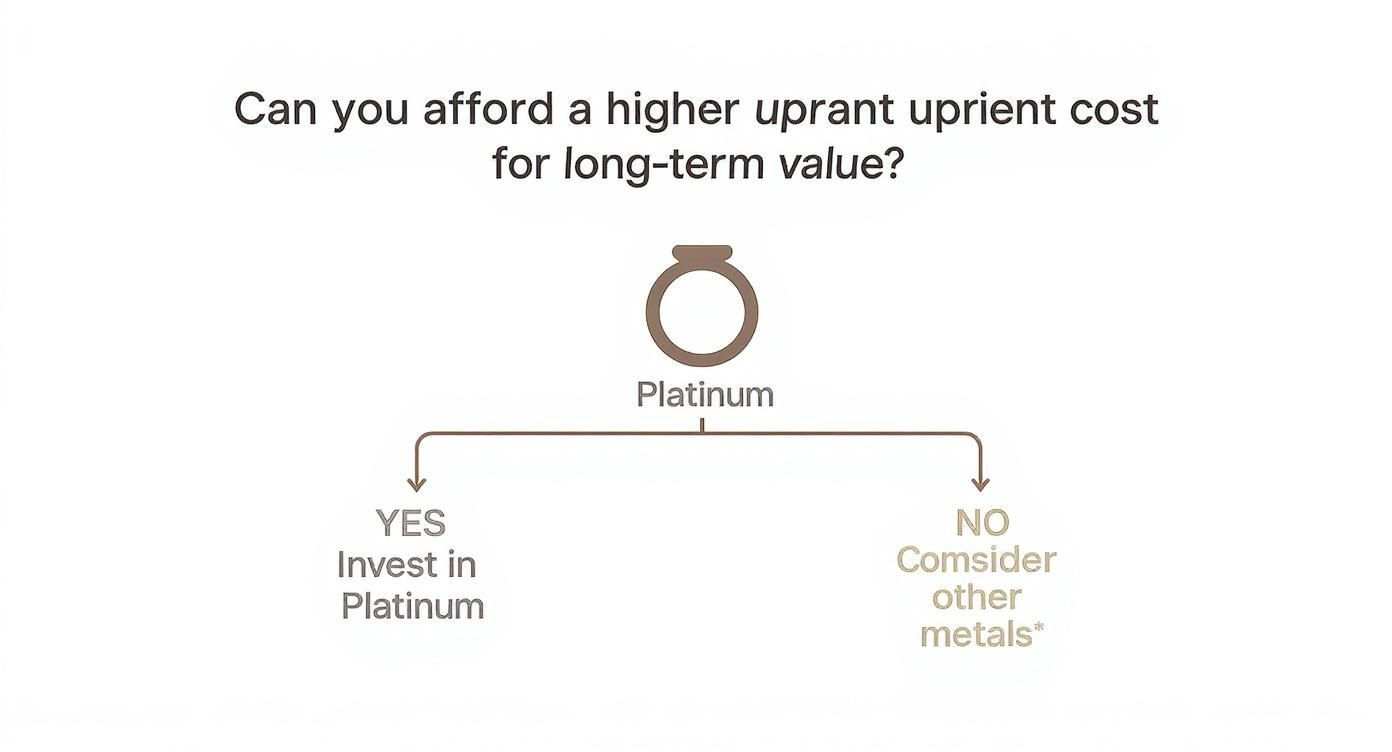
The takeaway? Platinum's higher ticket price is often balanced out by its minimal lifetime costs, making it a brilliant long-term investment in a piece you'll wear forever.
A Look at Popular Platinum Ring Styles
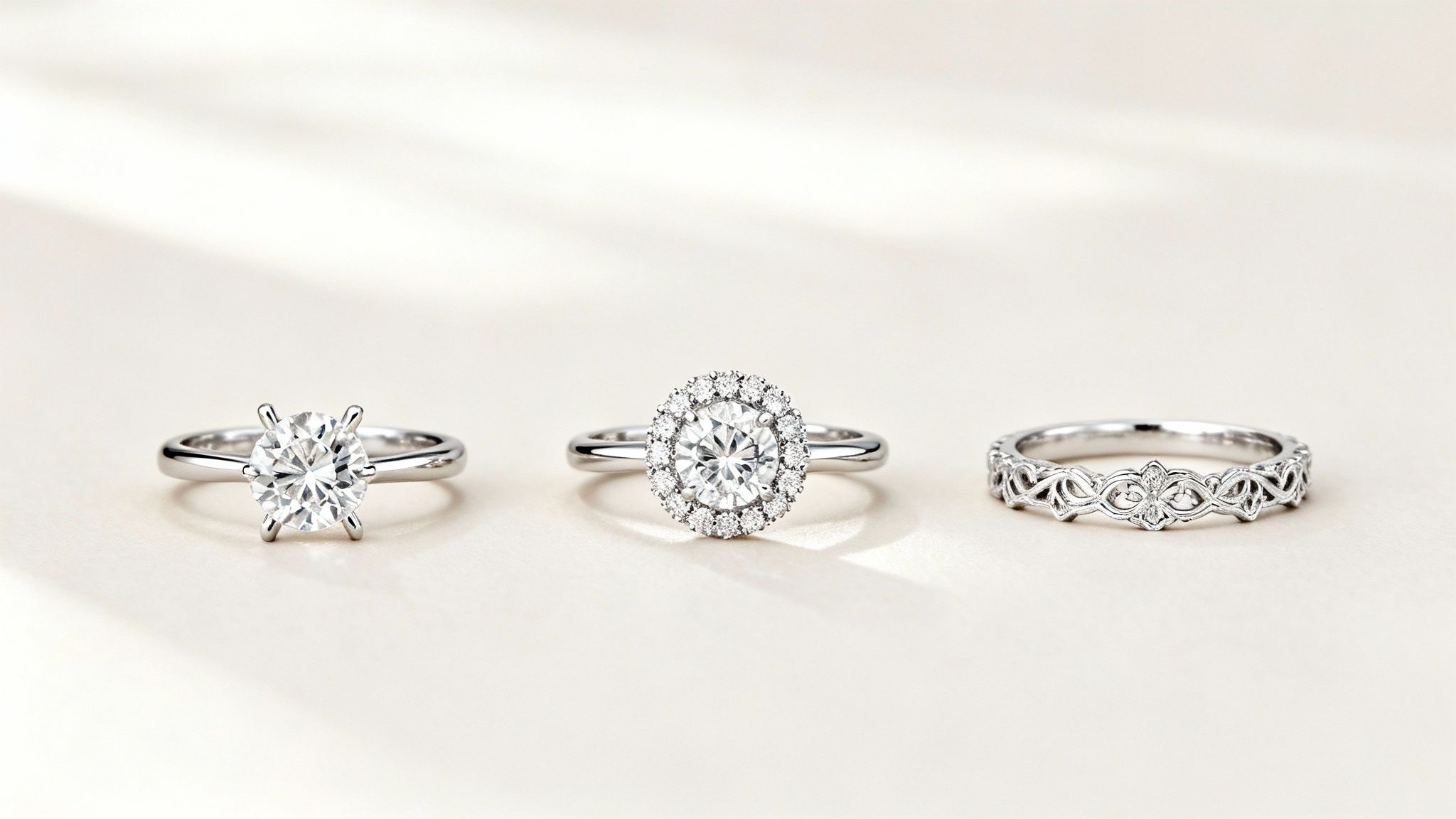
Now for the best part—exploring the incredible designs a platinum engagement ring can bring to life. Platinum isn't just another metal; it's a jeweller's dream material. Its rare blend of strength and workability lets artisans craft everything from timeless classics to intricate modern pieces with absolute precision.
The real beauty of platinum is its versatility. Its cool, neutral hue is the perfect canvas, making any gemstone it holds pop. Whether you’re drawn to the fire of a diamond or the deep tones of a sapphire, platinum’s pure white backdrop makes the stone the undeniable star of the show.
Let's walk through some of the most popular styles in the UK and see exactly how platinum elevates each one.
The Timeless Solitaire Setting
The solitaire is the quintessential engagement ring, loved for its clean, elegant simplicity. It’s all about a single, stunning gemstone held in a precious metal band, putting all the focus right where it belongs. With a design this pure, the quality of the setting is everything, and this is where platinum really shines.
Think about the prongs holding your diamond. In platinum, these claws are incredibly strong and dense, giving you ultimate security without being thick or bulky. This allows for that delicate, minimalist look while ensuring your diamond is held safely for a lifetime. Platinum's strength means jewellers can create finer, more elegant settings that let more light into the diamond, seriously boosting its sparkle.
Intricate Halo and Pavé Designs
If you love a bit of extra sparkle, halo and pavé settings are huge favourites. A halo encircles the centre stone with a ring of smaller diamonds, creating a dazzling frame that makes the main stone look bigger. A pavé band is meticulously set with tiny diamonds, creating a continuous, glittering surface.
These styles demand exceptional durability to keep every single stone perfectly in place. Platinum's density makes it the ideal metal for the job. It provides a secure foundation for these complex designs, ensuring the tiny beads of metal holding each diamond stay strong through decades of daily wear. Its natural white colour also blends seamlessly with the diamonds, creating an unbroken river of light.
Platinum’s remarkable strength allows for the most delicate and complex designs without compromising on security. It’s the silent guardian that ensures every tiny detail of an intricate ring remains perfect.
This reliability is exactly why artisans prefer platinum for their most ambitious and detailed creations.
Vintage and Modern Styles
Right now in the UK, we're seeing a huge appreciation for both vintage-inspired and clean, modern designs—and platinum excels in both arenas.
For vintage looks, platinum's workability allows for the delicate filigree (ornate metalwork) and milgrain (tiny beaded edges) that defined the Art Deco and Edwardian eras. Its ability to hold fine, intricate shapes makes it perfect for capturing the romance of antique jewellery.
On the other hand, platinum lends itself beautifully to sleek, modern styles. Its substantial weight and cool, lustrous finish are perfect for minimalist bands or contemporary tension settings, where the diamond seems to float between two ends of the band.
While recent economic caution has seen the average engagement ring spend dip in the UK, platinum holds its strong position at the top end of the market. This is especially true for bespoke designs where craftsmanship is key. It's a trend noted by Rêve Diamonds, which sees a growing demand for custom pieces that benefit from platinum's premium feel. You can read the full research on 2025 UK engagement ring trends to learn more.
Whether your heart is set on a classic, a vintage treasure, or a modern statement piece, a platinum engagement ring offers the perfect blend of beauty and brawn to bring your vision to life.
Caring for Your Platinum Engagement Ring
One of platinum’s best features is just how little looking after it needs. This is a metal that’s truly built for a lifetime of wear, and keeping it looking its best is surprisingly straightforward.
Because platinum’s cool white lustre is its natural state—not a plating—it will never fade. But everyday life, from hand lotions to soap, can build up a film that temporarily dulls its shine. A simple clean is all it takes to bring back that brilliance.
Understanding the Platinum Patina
Over the years, your platinum ring will develop a soft, silvery finish known as a patina. Many people grow to love this look, as it gives the ring a distinguished, almost frosted appearance that tells the story of your life together.
It’s important to know this isn’t damage. When other metals get scratched, a tiny sliver of metal is lost. When platinum is scratched, the metal is simply moved around on the surface. This displacement is what creates the patina. If you prefer the original high-shine look, a quick professional polish will restore it. The choice is yours.
Simple At-Home Cleaning
You don’t need any special chemicals to keep your ring sparkling. A quick soak at home is usually enough to dislodge the daily build-up.
Here’s how to do it:
- Mix a Gentle Solution: Add a few drops of mild washing-up liquid to a bowl of warm water.
- Soak Your Ring: Let the ring sit in the solution for about 15-20 minutes. This will loosen any oils, dirt, or cosmetic residue.
- Gently Brush: Use a soft-bristled toothbrush to carefully clean around the diamond and underneath the setting, where grime tends to collect.
- Rinse and Dry: Rinse it well under warm running water, then pat it dry with a soft, lint-free cloth.
This gentle method is safe to do every few weeks. It keeps your diamond looking brilliant and helps maintain the platinum’s natural lustre.
For a deeper dive into looking after your jewellery, our guide to cleaning wedding rings has more helpful tips.
When to Seek a Professional Polish
If you find you miss that original, mirror-like shine, a professional polish is the answer. A jeweller uses specialised buffing tools to gently move the displaced metal back into place, erasing the patina and restoring its bright, high-gloss finish.
A professional polish will make your ring look brand new again. It’s a great idea to have this done every few years or simply whenever you feel it’s ready for a refresh.
Everyday Care and Storage Tips
Platinum is incredibly tough, but a few good habits will keep your ring safe and looking perfect.
- Store It Safely: When you’re not wearing it, keep your ring in a soft pouch or a fabric-lined jewellery box, away from other pieces that could scratch it.
- Avoid Harsh Chemicals: Always take your ring off before handling strong chemicals like bleach or cleaning agents.
- Be Mindful During Activities: It’s best to remove your ring before doing heavy work like gardening, hitting the gym, or moving furniture to protect it from sharp impacts.
Your Platinum Ring Questions, Answered
Choosing a platinum engagement ring is a big decision, and it’s natural to have a few final questions. It's a significant purchase, and you should feel completely confident. Here, we tackle the most common practical queries we hear, giving you clear, direct answers to help you choose the ring of your dreams.
Think of this as your final checklist, making sure every detail is covered so you have total peace of mind.
Is a Platinum Ring Too Heavy for Everyday Wear?
One of the first things people notice about platinum is its satisfying heft. Because it's denser than gold, a platinum ring feels more substantial on your finger. You might be very aware of it at first, but this feeling is almost always short-lived.
Most people quickly get used to the weight and grow to love it. Instead of feeling heavy, it becomes a reassuring, tangible reminder of the ring's quality and what it represents. The weight signals luxury, not inconvenience, making it perfectly comfortable for a lifetime of daily wear.
Will My Platinum Ring Scratch Easily?
This is a great question, because the answer reveals one of platinum’s most unique qualities. Yes, like any precious metal, platinum will get scratched through daily wear. But what happens next is completely different from other metals.
When gold is scratched, a tiny piece of metal is lost forever. Over many years, this can cause the ring to gradually wear thin.
When platinum is scratched, the metal is simply displaced—moved from one spot on the ring to another. No volume is lost. This movement creates the famous platinum patina, a soft, satiny finish that many people cherish as a symbol of their life together. It’s a mark of authenticity, not damage.
A scratch on a platinum ring isn't a loss of metal, but a rearrangement of it. This unique property is why the prongs holding your gemstone remain thick and secure for decades, offering unparalleled protection.
And if you prefer the original high-shine look? A professional polish from a skilled jeweller will easily restore that bright, mirror-like finish, making your ring look brand new again.
Can You Resize a Platinum Engagement Ring?
Absolutely. It’s a common misconception that platinum’s strength makes it hard to resize. While it does require a jeweller with specialist skills and equipment, resizing a platinum engagement ring is a very routine procedure for an expert.
The process is a bit more demanding than resizing gold due to platinum's incredibly high melting point and its resistance to being worked. This is why you must entrust the job to a professional.
- Specialised Tools Are Needed: Jewellers use torches that can reach much higher temperatures to work with platinum.
- Expertise is Key: A craftsman experienced with platinum knows exactly how to add or remove metal and polish the ring to a seamless finish.
- Always Use a Trusted Professional: For the best results, always go back to your original jeweller or another reputable workshop for any adjustments.
So, rest assured, if your finger size changes over the years, your platinum ring can be adjusted to fit perfectly.
Is Platinum a Good Long-Term Investment?
When you think of an engagement ring as an "investment," it helps to look beyond the day-to-day market price of the metal. The real value of a platinum ring is in its longevity, low maintenance, and enduring beauty—qualities that make it an incredibly wise choice for a piece meant to last a lifetime.
Here's why it's a sound investment in the long run:
- Durability: Its strength means your setting stays secure, drastically reducing the risk of losing your diamond. This alone can save you from potential heartbreak and huge replacement costs.
- Low Maintenance Costs: Unlike white gold, platinum never needs rhodium replating to keep its brilliant white colour. This saves you the recurring cost and hassle of visiting a jeweller every few years.
- Timeless Appeal: Platinum’s classic, cool lustre never goes out of style. It will be just as stunning on your golden anniversary as it was on your wedding day.
- Hypoallergenic Properties: At 95% pure, it's the kindest metal for sensitive skin, ensuring you can wear it comfortably every day without worry.
While the initial cost is higher, a platinum engagement ring often proves more cost-effective over a lifetime. You're investing in peace of mind, security, and timeless elegance—and those qualities are priceless.
At Opulence Jewellery Services, our Hatton Garden workshop is home to master jewellers with decades of experience working with precious metals like platinum. Whether you need a ring resized, polished to perfection, or a custom design brought to life, our team has the expertise to care for your most cherished pieces. Explore our expert jewellery services and see how we can help.
